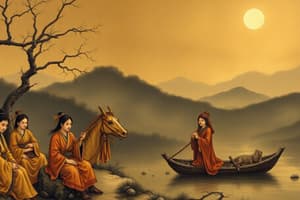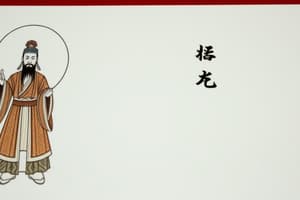Podcast
Questions and Answers
What feature significantly influenced the agricultural development in early China?
What feature significantly influenced the agricultural development in early China?
- Floods from the Ganges River
- Fertile plains from the Yangzi River
- The Loess soil deposited by glaciers (correct)
- Volcanic soil richness
Which dynasties played a crucial role in establishing regional states in early China?
Which dynasties played a crucial role in establishing regional states in early China?
- Yuan, Ming, and Qing
- Sui, Wei, and Jin
- Xia, Shang, and Zhou (correct)
- Tang, Song, and Han
What characteristic of the Yellow River contributes to its appearance?
What characteristic of the Yellow River contributes to its appearance?
- It has a stable and predictable current.
- It carries large amounts of loess soil. (correct)
- It channels blue-colored water.
- It is filled with salt deposits.
What was the primary political organization of early Chinese settlements before larger regional states formed?
What was the primary political organization of early Chinese settlements before larger regional states formed?
How did the geographical characteristics of the Yellow River affect its flow?
How did the geographical characteristics of the Yellow River affect its flow?
What was a significant environmental challenge posed by the Yellow River?
What was a significant environmental challenge posed by the Yellow River?
The term 'loess' refers to which of the following?
The term 'loess' refers to which of the following?
Which river valley is associated with the earliest complex society in East Asia?
Which river valley is associated with the earliest complex society in East Asia?
What was a significant method used by Shang rulers to maintain their authority?
What was a significant method used by Shang rulers to maintain their authority?
What roles did ministers and craftsmen play in Shang society?
What roles did ministers and craftsmen play in Shang society?
How many times did the Shang capital move during the dynasty?
How many times did the Shang capital move during the dynasty?
What was one of the primary reasons for the selection of the Shang capitals?
What was one of the primary reasons for the selection of the Shang capitals?
What characterized the city wall of the Shang capital Ao?
What characterized the city wall of the Shang capital Ao?
Who was Fu Hao in relation to the Shang dynasty?
Who was Fu Hao in relation to the Shang dynasty?
What was a key aspect of the Shang cities beyond administration and military?
What was a key aspect of the Shang cities beyond administration and military?
The construction method of the Shang city walls involved which technique?
The construction method of the Shang city walls involved which technique?
What was the primary purpose of the Book of Changes during the Zhou dynasty?
What was the primary purpose of the Book of Changes during the Zhou dynasty?
Which work emphasized the importance of obedience to the ruling elites?
Which work emphasized the importance of obedience to the ruling elites?
What were the Zhou writers mainly known for in their less famous works?
What were the Zhou writers mainly known for in their less famous works?
Which of the following is NOT a name used for the Book of Songs?
Which of the following is NOT a name used for the Book of Songs?
What educational role did the works of Zhou literature serve in ancient Chinese schools?
What educational role did the works of Zhou literature serve in ancient Chinese schools?
Which of the following texts was primarily focused on rituals and proper behavior?
Which of the following texts was primarily focused on rituals and proper behavior?
During which period did the Zhou dynasty's literary influence take place?
During which period did the Zhou dynasty's literary influence take place?
Which statement about the works of Zhou writers is accurate?
Which statement about the works of Zhou writers is accurate?
What was a primary reason for the founding of cities during the Shang dynasty?
What was a primary reason for the founding of cities during the Shang dynasty?
Which dynasty is traditionally regarded as succeeding the Xia dynasty?
Which dynasty is traditionally regarded as succeeding the Xia dynasty?
What features were discovered in the recently excavated city of Erlitou?
What features were discovered in the recently excavated city of Erlitou?
What is the time frame traditionally assigned to the Shang dynasty?
What is the time frame traditionally assigned to the Shang dynasty?
How did the Shang dynasty reportedly come to power in relation to the Xia dynasty?
How did the Shang dynasty reportedly come to power in relation to the Xia dynasty?
What role did bronze weapons play in the Shang dynasty?
What role did bronze weapons play in the Shang dynasty?
What was noted about the last king of the Xia dynasty?
What was noted about the last king of the Xia dynasty?
Which technological aspect contributed to the growth of early Chinese states?
Which technological aspect contributed to the growth of early Chinese states?
What tool production significantly aided the Early Zhou rulers in building a sizable kingdom?
What tool production significantly aided the Early Zhou rulers in building a sizable kingdom?
What social institution emerged as the most influential in shaping individuals' lives during the Zhou dynasty?
What social institution emerged as the most influential in shaping individuals' lives during the Zhou dynasty?
Which class primarily occupied the highest social positions during the Xia, Shang, and Zhou dynasties?
Which class primarily occupied the highest social positions during the Xia, Shang, and Zhou dynasties?
How did the ruling elites utilize the agricultural surplus during the Shang and early Zhou dynasties?
How did the ruling elites utilize the agricultural surplus during the Shang and early Zhou dynasties?
What was a key characteristic of the bronze weaponry used by ruling elites?
What was a key characteristic of the bronze weaponry used by ruling elites?
What impact did the establishment of regional states have on the political landscape of early China?
What impact did the establishment of regional states have on the political landscape of early China?
What was one consequence of the high cost of bronze during the Shang dynasty?
What was one consequence of the high cost of bronze during the Shang dynasty?
What contributed to the distinction between social classes during the Zhou dynasty?
What contributed to the distinction between social classes during the Zhou dynasty?
What was a primary reason that nomadic peoples settled in the grassy steppe lands of central Asia?
What was a primary reason that nomadic peoples settled in the grassy steppe lands of central Asia?
Which of the following was a major development among Indo-European peoples in the western steppes around 4000 B.C.E.?
Which of the following was a major development among Indo-European peoples in the western steppes around 4000 B.C.E.?
What was one of the main products that nomadic peoples obtained from agricultural societies?
What was one of the main products that nomadic peoples obtained from agricultural societies?
How did nomadic societies serve agricultural societies in their interactions?
How did nomadic societies serve agricultural societies in their interactions?
What adaptation did nomadic peoples make to their way of life by 2900 B.C.E.?
What adaptation did nomadic peoples make to their way of life by 2900 B.C.E.?
What materials did nomadic peoples primarily utilize from their herds?
What materials did nomadic peoples primarily utilize from their herds?
Which development primarily occurred after 1000 B.C.E. among nomadic societies?
Which development primarily occurred after 1000 B.C.E. among nomadic societies?
What significant knowledge did nomadic peoples bring from southwest Asia?
What significant knowledge did nomadic peoples bring from southwest Asia?
Flashcards
Yellow River's Name
Yellow River's Name
The Yellow River, often referred to as "Huang He", gets its name from the vast quantities of light-colored loess soil it carries.
Loess Soil
Loess Soil
Loess is a very fine, powdery soil deposited in northern China by glaciers retreating after the last ice age.
Yellow River's Appearance
Yellow River's Appearance
The vast amounts of loess carried by the Yellow River cause it to become yellow and resemble a thick soup.
Yellow River's Shifting Path
Yellow River's Shifting Path
Signup and view all the flashcards
Yellow River's Nature
Yellow River's Nature
Signup and view all the flashcards
Yellow River's Length
Yellow River's Length
Signup and view all the flashcards
Early Chinese Settlements
Early Chinese Settlements
Signup and view all the flashcards
Rise of Regional States
Rise of Regional States
Signup and view all the flashcards
Shang Dynasty's focus on cities and metallurgy
Shang Dynasty's focus on cities and metallurgy
Signup and view all the flashcards
Transition from Xia to Shang
Transition from Xia to Shang
Signup and view all the flashcards
Shang Dynasty Timeline
Shang Dynasty Timeline
Signup and view all the flashcards
Erlitou: Possible Xia Capital
Erlitou: Possible Xia Capital
Signup and view all the flashcards
Technology and Early Chinese States
Technology and Early Chinese States
Signup and view all the flashcards
Shang Dynasty’s Success
Shang Dynasty’s Success
Signup and view all the flashcards
Shang Dynasty: Weapons and Urbanization
Shang Dynasty: Weapons and Urbanization
Signup and view all the flashcards
Technology's Role in Shang Success
Technology's Role in Shang Success
Signup and view all the flashcards
Decentralized Shang Rule
Decentralized Shang Rule
Signup and view all the flashcards
Impact of Iron Technology on Zhou Dynasty
Impact of Iron Technology on Zhou Dynasty
Signup and view all the flashcards
Shang Military Strength
Shang Military Strength
Signup and view all the flashcards
Patriarchal Family in Ancient China
Patriarchal Family in Ancient China
Signup and view all the flashcards
Multifaceted Shang Capitals
Multifaceted Shang Capitals
Signup and view all the flashcards
Ruling Elites in Early China
Ruling Elites in Early China
Signup and view all the flashcards
Bronze as a Status Symbol
Bronze as a Status Symbol
Signup and view all the flashcards
Shang City Walls
Shang City Walls
Signup and view all the flashcards
Network of Walled Towns
Network of Walled Towns
Signup and view all the flashcards
Bronze Weaponry and Power
Bronze Weaponry and Power
Signup and view all the flashcards
Emergence of Social Class in Ancient China
Emergence of Social Class in Ancient China
Signup and view all the flashcards
Shang Political Allies
Shang Political Allies
Signup and view all the flashcards
Shang Craftsmanship
Shang Craftsmanship
Signup and view all the flashcards
Lifestyle of Ruling Elites
Lifestyle of Ruling Elites
Signup and view all the flashcards
The Development of Ancient Chinese Social Order
The Development of Ancient Chinese Social Order
Signup and view all the flashcards
Shang Dominion
Shang Dominion
Signup and view all the flashcards
Zhou Literature
Zhou Literature
Signup and view all the flashcards
Book of Changes
Book of Changes
Signup and view all the flashcards
Book of History
Book of History
Signup and view all the flashcards
Book of Etiquette (Book of Rites)
Book of Etiquette (Book of Rites)
Signup and view all the flashcards
Book of Songs (Book of Poetry, Book of Odes)
Book of Songs (Book of Poetry, Book of Odes)
Signup and view all the flashcards
Zhou literature's impact on Education
Zhou literature's impact on Education
Signup and view all the flashcards
Zhou writers' keen observations
Zhou writers' keen observations
Signup and view all the flashcards
Less famous Zhou works
Less famous Zhou works
Signup and view all the flashcards
Steppes of Central Asia
Steppes of Central Asia
Signup and view all the flashcards
Pastoral Societies
Pastoral Societies
Signup and view all the flashcards
Steppe Nomads
Steppe Nomads
Signup and view all the flashcards
Impact of Horse Domestication
Impact of Horse Domestication
Signup and view all the flashcards
Steppe Nomads as Intermediaries
Steppe Nomads as Intermediaries
Signup and view all the flashcards
Nomadic Dependence on Agriculture
Nomadic Dependence on Agriculture
Signup and view all the flashcards
Role of Nomads in Cultural Exchange
Role of Nomads in Cultural Exchange
Signup and view all the flashcards
Diffusion of Technology
Diffusion of Technology
Signup and view all the flashcards
Study Notes
Early Society in East Asia
- Early Chinese legends feature sage-kings (Yao, Shun, and Yu) credited with establishing foundations of Chinese society, including agriculture, family structures, and timekeeping.
- Yu, a prominent sage-king, is celebrated for controlling the flooding Yellow River, thus facilitating agriculture and establishing the Xia dynasty, the first Chinese dynasty.
- The Xia dynasty is considered the first dynasty, although its existence is largely confirmed by archaeological findings.
- The Shang dynasty (1766–1122 BCE) succeeded the Xia, leaving written records and material remains, providing insights into early Chinese society.
- The Shang dynasty utilized bronze metallurgy for tools and weapons, enabling control over agricultural areas and establishing a more powerful state structure.
- Shang kings used chariots, and their ability to control bronze production provided them with a military advantage over other regions.
- The Zhou dynasty (1122–256 BCE) succeeded the Shang, legitimizing their rule through the "Mandate of Heaven" theory.
- The Zhou dynasty expanded and centralized authority, establishing a more decentralized administration compared to their predecessor.
Political Organization
- Early China's political organization evolved from localized village control towards regional states led by Xia, Shang, and Zhou dynasties.
- The Xia dynasty was an early effort to organize public life, and it was followed by the more powerful state of Shang.
- The Shang rulers expanded their influence to areas around modern-day Henan through military force.
- The Zhou dynasty implemented a decentralized administration which relied on subordinates and allies.
- Eventually, the Zhou rulers lost effective control, and various independent states emerged during the Warring States period (403–221 BCE).
Society and Family
- Family was a key social institution, and the patriarchal family structure played a crucial role.
- Early Chinese elites occupied the most prominent positions in society, particularly the royal and noble families.
- Bronze tools and objects were symbols of wealth and status, distinguishing the elites from the common people.
- The veneration of ancestors was a significant cultural practice, shaping family values and social structures.
Early Chinese Writing
- Writing in China emerged during the Shang dynasty; inscriptions on oracle bones are the earliest evidence of Chinese writing.
- Oracle bones were used for divination, recording events at the Shang royal court.
- The earliest Chinese writing used pictographs and ideographs, which differed from alphabetic systems.
- Written language became progressively more stylized, sophisticated, and complex over time.
Culture and Development
- The development of agriculture was critical in the establishment of early Chinese societies.
- The Yellow River and Yangzi valleys were important agricultural areas.
- Nomadic groups interacted and traded with settled agricultural communities, influencing cultural practices.
- The southern expansion of Chinese society led to the development of rice farming in the Yangzi Valley, introducing new agricultural techniques.
- Early Chinese developed their writing systems, which provided a medium for recording events, thoughts, and experiences.
- Written traditions contributed to the expression of cultural ideas and the establishment of philosophical traditions.
Studying That Suits You
Use AI to generate personalized quizzes and flashcards to suit your learning preferences.




